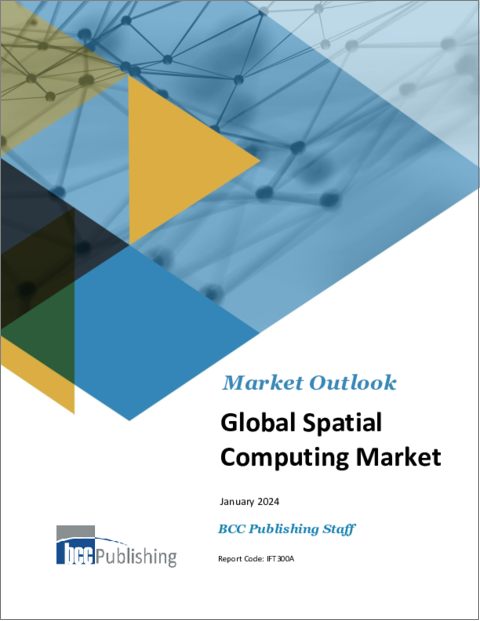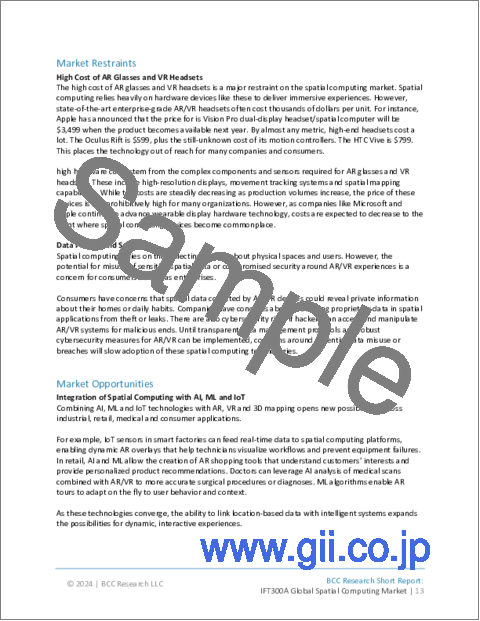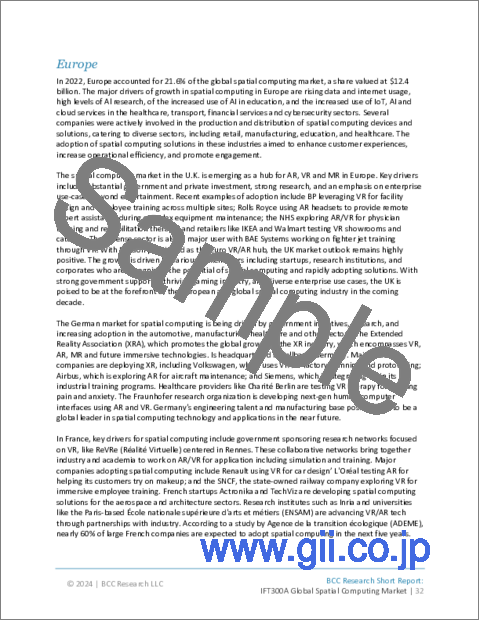|
|
市場調査レポート
商品コード
1396662
空間コンピューティングの世界市場Global Spatial Computing Market |
||||||
|
|||||||
| 空間コンピューティングの世界市場 |
|
出版日: 2023年12月14日
発行: BCC Research
ページ情報: 英文 57 Pages
納期: 即納可能
|
- 全表示
- 概要
- 図表
- 目次
当レポートでは、世界の空間コンピューティングの市場を調査し、市場概要・背景、市場影響因子および市場機会の分析、法規制環境、技術動向、市場規模の推移・予測、各種区分・地域別の詳細分析、ESGの展開、競合情勢、主要企業のプロファイルなどをまとめています。
目次
第1章 イントロダクション
第2章 サマリー・ハイライト
- 市場の見通し
- 市場サマリー
第3章 市場概要
- 概要
- 空間コンピューティングのプロセス
- メタバースと空間コンピューティングの関係
- 規制の枠組み
- 市場力学
- 市場促進要因
- 市場抑制要因
- 市場機会
- 新技術
- ARクラウド
- ERセンシング
- 3D没入型ホログラム
- フォトリアリスティックレンダリング
第4章 市場内訳:提供区分・技術・産業別
- 空間コンピューティング市場:提供区分別
- ハードウェア
- ソフトウェア
- サービス
- 空間コンピューティング市場:技術別
- AR
- VR
- MR
- IoT
- AI
- その他
- 市場規模・予測
- 空間コンピューティング市場:産業別
- ヘルスケア
- 航空宇宙・防衛
- 製造
- 小売・eコマース
- 自動車
- 旅行・ホスピタリティ
- メディア・エンターテイメント
- その他
- 市場規模・予測
第5章 市場内訳:地域別
- 北米
- 欧州
- アジア太平洋
- その他の地域
第6章 空間コンピューティング業界の持続可能性:ESGの観点
- 空間コンピューティングにおけるESGの課題
- 二酸化炭素排出量/環境への影響
- 電気
- ESGパフォーマンス分析
- ケーススタディ
- BCCによる総論
第7章 競合情勢
- 概要
- 市場シェア分析
- 戦略的分析
第8章 企業プロファイル
- APPLE INC.
- EPIC GAMES INC.
- GOOGLE LLC
- HTC CORP.
- INTEL CORP.
- MAGIC LEAP INC.
- META PLATFORMS INC.
- MICROSOFT CORP.
- NVIDIA CORP.
- QUALCOMM TECHNOLOGIES INC.
- SONY CORP.
- UNITY SOFTWARE INC.
- VARJO TECHNOLOGIES OY
- VUZIX CORP.
第9章 付録
List of Tables
- Summary Table : Global Market for Spatial Computing, by Region, Through 2028
- Table 1 : Global Market for Spatial Computing, by Offering, Through 2028
- Table 2 : Global Market for Spatial Computing, by Technology, Through 2028
- Table 3 : Global Market for Spatial Computing, by Industry, Through 2028
- Table 4 : Global Market for Spatial Computing, by Region, Through 2028
- Table 5 : North American Market for Spatial Computing, by Country, Through 2028
- Table 6 : North American Market for Spatial Computing, by Offering, Through 2028
- Table 7 : North American Market for Spatial Computing, by Technology, Through 2028
- Table 8 : North American Market for Spatial Computing, by Industry, Through 2028
- Table 9 : European Market for Spatial Computing, by Country, Through 2028
- Table 10 : European Market for Spatial Computing, by Offering, Through 2028
- Table 11 : European Market for Spatial Computing, by Technology, Through 2028
- Table 12 : European Market for Spatial Computing, by Industry, Through 2028
- Table 13 : Asia-Pacific Market for Spatial Computing, by Country, Through 2028
- Table 14 : Asia-Pacific Market for Spatial Computing, by Offering, Through 2028
- Table 15 : Asia-Pacific Market for Spatial Computing, by Technology, Through 2028
- Table 16 : Asia-Pacific Market for Spatial Computing, by Industry, Through 2028
- Table 17 : RoW Market for Spatial Computing, by Subregion, Through 2028
- Table 18 : RoW Market for Spatial Computing, by Offering, Through 2028
- Table 19 : RoW Market for Spatial Computing, by Technology, Through 2028
- Table 20 : RoW Market for Spatial Computing, by Industry, Through 2028
- Table 21 : Environmental Metrics for the Spatial Computing Industry
- Table 22 : Social Metrics for the Market for Spatial Computing
- Table 23 : Governance Metrics for the Market for Spatial Computing
- Table 24 : Recent Developments in the Spatial Computing Industry, 2023
- Table 25 : Apple Inc.: Products
- Table 26 : Epic Games Inc.: Products
- Table 27 : Google LLC : Products
- Table 28 : HTC Corp.: Products
- Table 29 : Intel Corp.: Products
- Table 30 : Magic Leap Inc.: Products
- Table 31 : Meta Platforms Inc.: Products
- Table 32 : Microsoft Corp.: Products
- Table 33 : Nvidia Corp.: Products
- Table 34 : Qualcomm Technologies Inc.: Products
- Table 35 : Sony Corp.: Products
- Table 36 : Unity Software Inc.: Products
- Table 37 : Varjo Technologies OY: Products
- Table 38 : Vuzix Corp.: Products
- Table 39 : Acronym Used in This Report
List of Figures
Figure A : Information Sources
- Summary Figure : Global Market Shares of Spatial Computing, by Region, 2022
- Figure 1 : Global Market Shares of Spatial Computing, by Offering, 2022
- Figure 2 : Global Market Shares of Spatial Computing, by Technology, 2022
- Figure 3 : Global Market Shares of Spatial Computing, by Industry, 2022
- Figure 4 : Global Market Shares of Spatial Computing, by Region, 2022
- Figure 5 : Market Shares of Leading Spatial Computing Companies, 2022
Highlights:
This report provides an overview of the global spatial computing market size analysis and a detailed analysis of the market player’s products and strategies. Using 2022 as the base year, the report provides estimated market data for 2023 through 2028. Revenue forecasts for this period are segmented based on component, technology, industry, and geography.
Report Scope:
The current report offers a detailed picture of the global spatial computing market. This report highlights the current and future market potential for spatial computing and provides a detailed analysis of the competitive environment, process, relationship of metaverse to spatial computing, drivers, restraints, opportunities, and trends in the market, emerging technologies, and regulatory framework. The report also covers market projections through 2028 and key market players. This report discusses spatial computing and its various resources. It covers the overall spatial computing market, including offering, technology, and industry. Furthermore, a complete regional analysis of the market is also presented in the report. Based on offering the market has been categorized into hardware, software, and services. Based on technology, the spatial computing market has been segmented into AR, VR, MR, Internet of Things (IoT), Artificial Intelligence, and others.
The market has been segmented based on geography into North America, Europe, Asia-Pacific, and the Rest of the World (including Latin America, the Middle East, and Africa). Detailed analyses of major countries (the U.S., Canada, Germany, the UK, France, Italy, Japan, China, and India) are covered in regional segments. For market estimates, data has been provided for 2022 as the base year, with forecasts for 2023 through 2028. Estimated values are based on revenue from spatial computing companies as total revenues. Projected and forecasted revenue values are in constant U.S. dollars that have not been adjusted for inflation.
Report Includes:
- An overview and in-depth analysis of the global spatial computing market
- Analyses of the global market trends, with historical market revenue data (sales figures) for 2022, estimates for 2023, forecasts for 2024, and projections of compound annual growth rates (CAGRs) through 2028
- Estimate of the actual market size and revenue forecast for the global spatial computing market, and corresponding market share analysis based on offering, technology, industry, and region
- Overview of the significant driving trends and challenges that affect the global market and its vendor landscape
- Discussion of sustainability trends and factors in the market for spatial computing, with emphasis on consumer attitudes, ESG score analysis, future of ESG, case study, and the ESG practices followed
- Analysis of the company competitive landscape based on their recent developments, key financials and segmental revenues, and product offerings
- Profiles of the leading market players
Table of Contents
Chapter 1 Introduction
- Study Goals and Objectives
- Reasons for Doing This Study
- Scope of Report
- Methodology
- Regional Breakdown
- Market Breakdown by Segment
Chapter 2 Summary and Highlights
- Market Outlook
- Market Summary
Chapter 3 Market Overview
- Overview
- Process of Spatial Computing
- Relationship of the Metaverse to Spatial Computing
- Regulatory Framework
- Market Dynamics
- Market Drivers
- Market Restraints
- Market Opportunities
- Emerging Technologies
- AR Cloud
- Extended Reality Sensing
- 3D Immersive Holograms
- Photorealistic Rendering
Chapter 4 Market Breakdown by Offering, Technology and Industry
- Market for Spatial Computing by Offering
- Hardware
- Software
- Services
- Market for Spatial Computing by Technology
- AR
- VR
- Mixed Reality
- Internet of Things
- Artificial Intelligence
- Other Technologies
- Market Size and Forecast
- Market for Spatial Computing by Industry
- Healthcare
- Aerospace and Defense
- Manufacturing
- Retail and E-commerce
- Automotive
- Travel and Hospitality
- Media and Entertainment
- Other Industries
- Market Size and Forecast
Chapter 5 Market Breakdown by Region
- Introduction
- North America
- Europe
- Asia-Pacific
- Rest of the World
Chapter 6 Sustainability in the Spatial Computing Industry: An ESG Perspective
- ESG Issues in Spatial Computing
- Carbon Footprint/Environmental Impact
- Electricity
- ESG Performance Analysis
- Case Studies
- Concluding Remarks from BCC Research
Chapter 7 Competitive Landscape
- Overview
- Market Share Analysis
- Strategic Analysis
Chapter 8 Company Profiles
- APPLE INC.
- EPIC GAMES INC.
- GOOGLE LLC
- HTC CORP.
- INTEL CORP.
- MAGIC LEAP INC.
- META PLATFORMS INC.
- MICROSOFT CORP.
- NVIDIA CORP.
- QUALCOMM TECHNOLOGIES INC.
- SONY CORP.
- UNITY SOFTWARE INC.
- VARJO TECHNOLOGIES OY
- VUZIX CORP.






